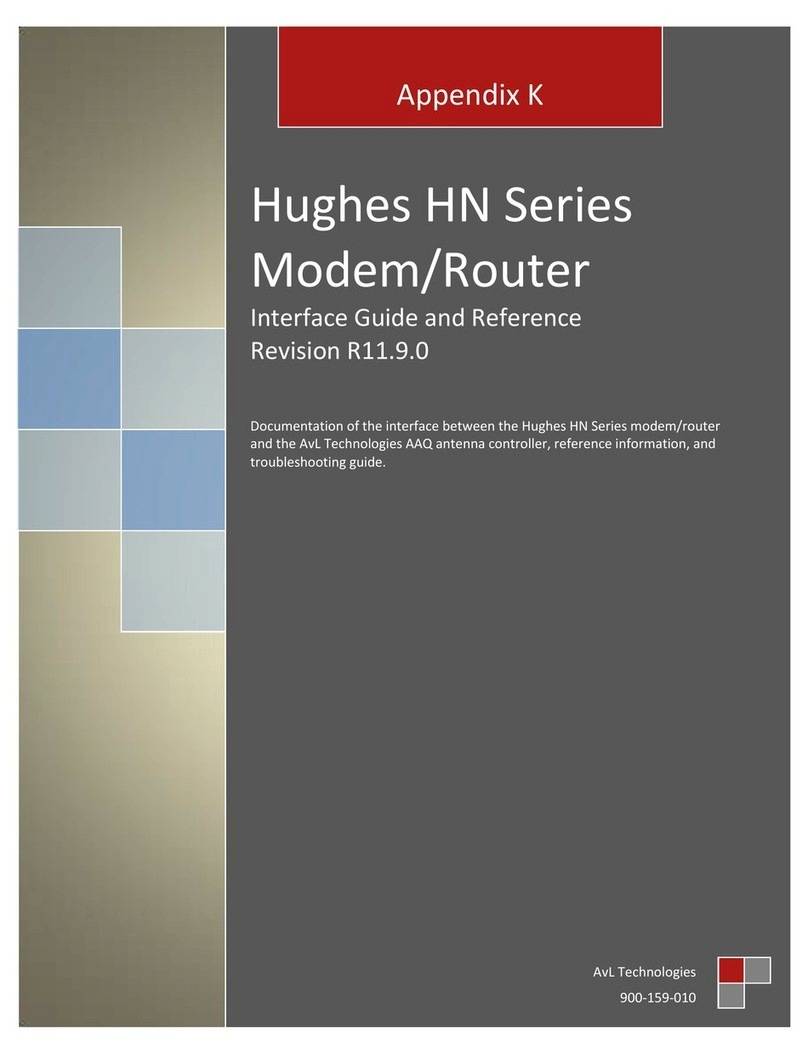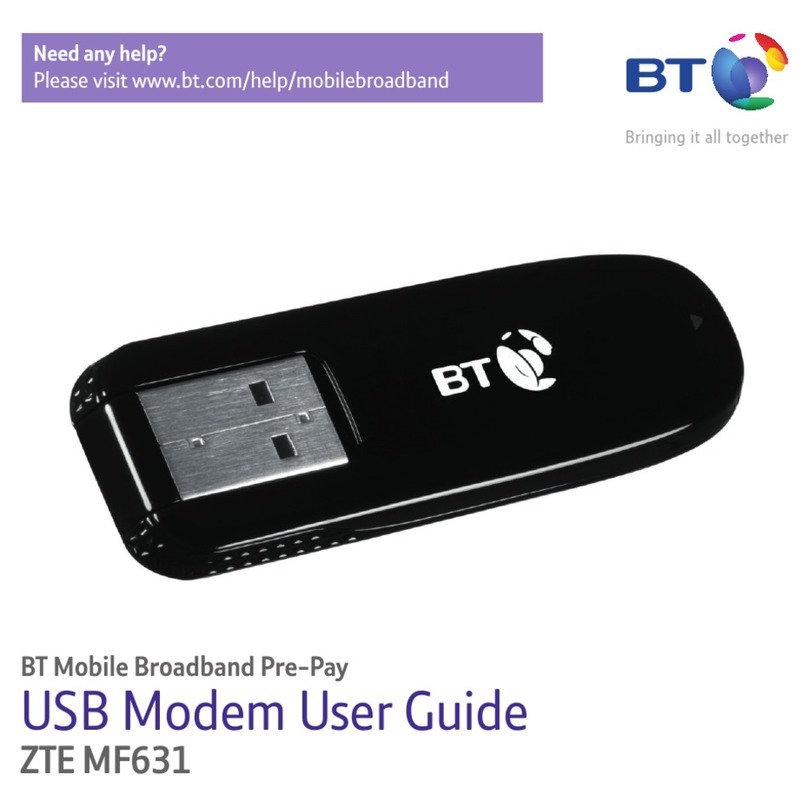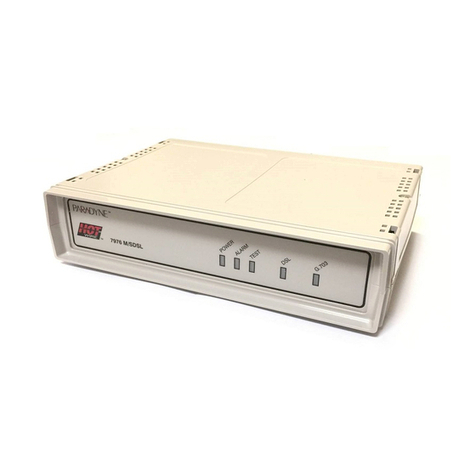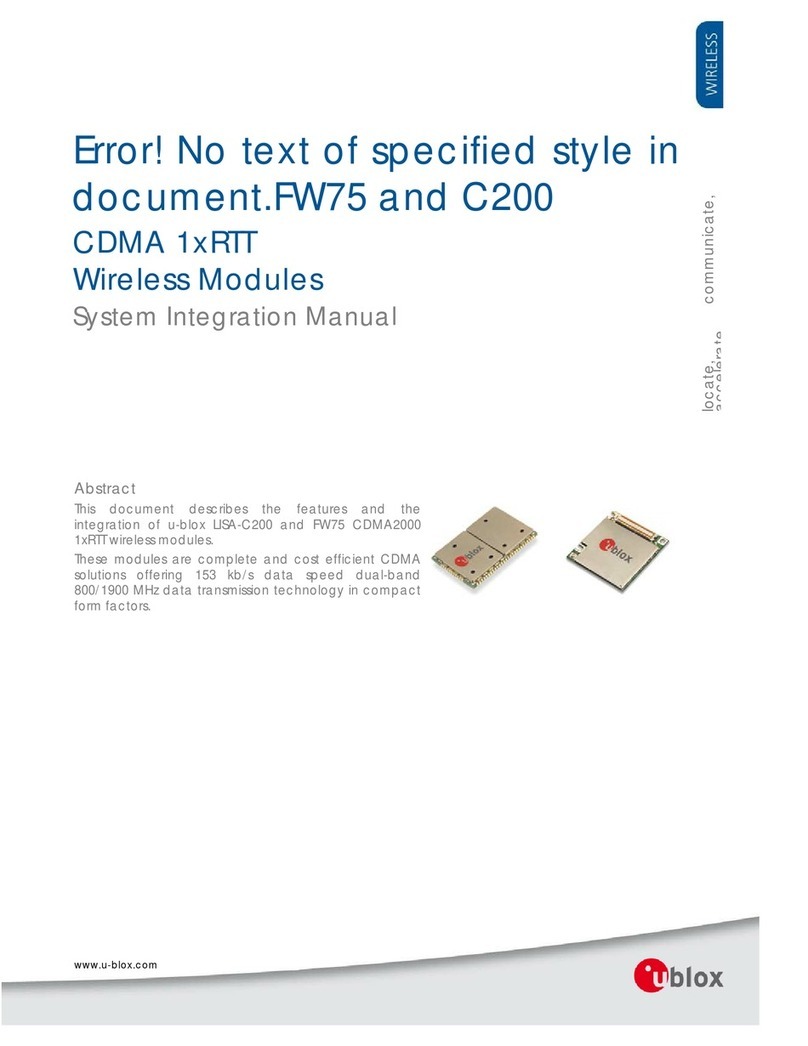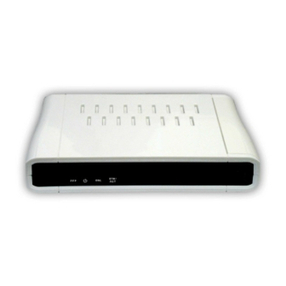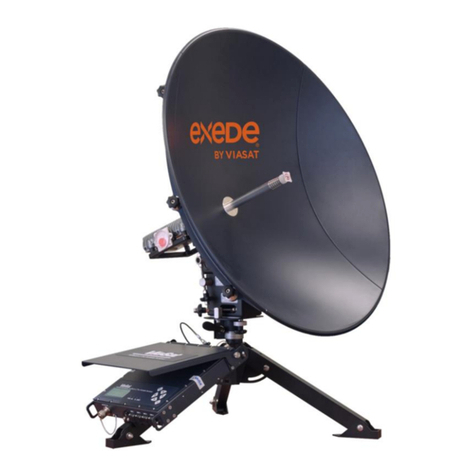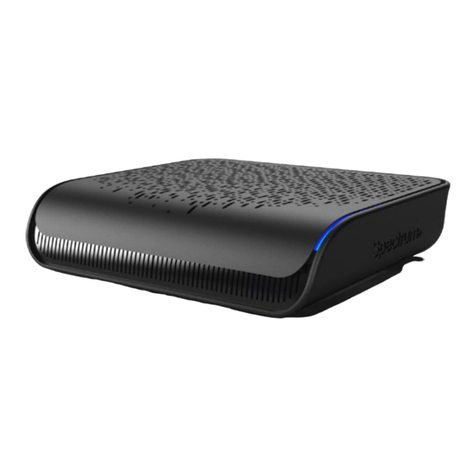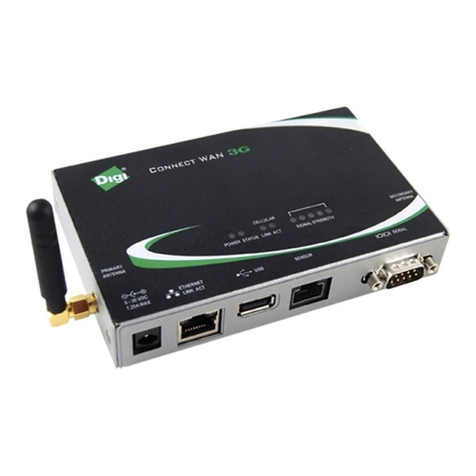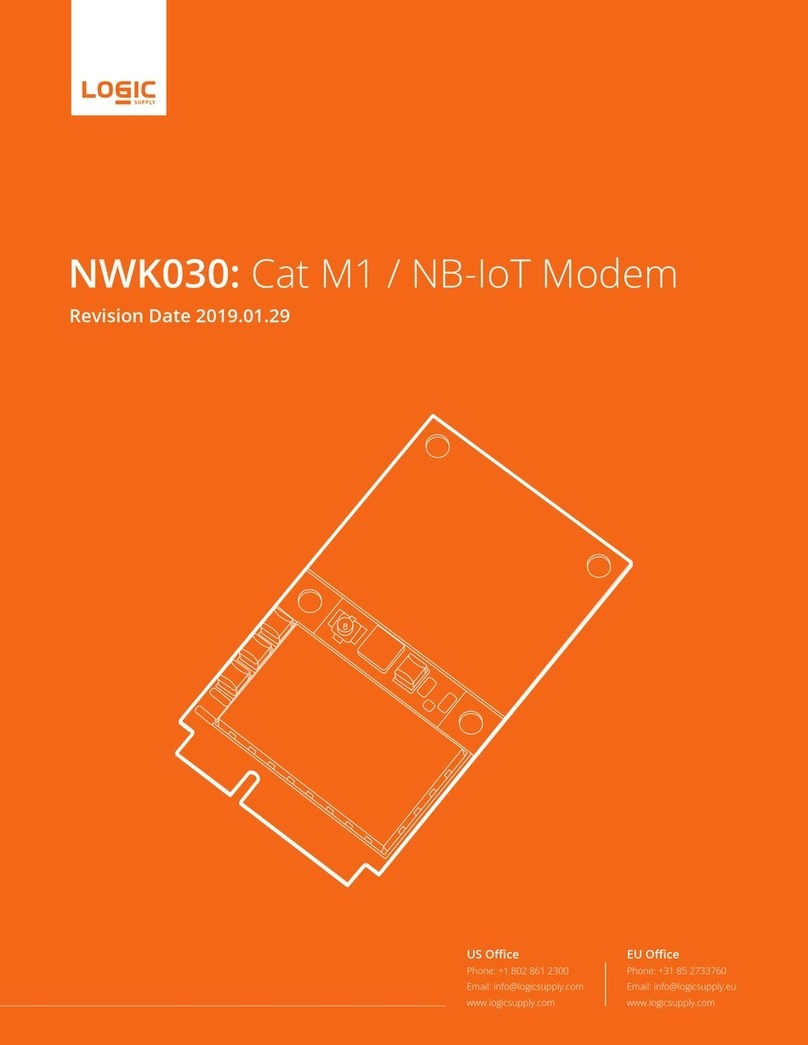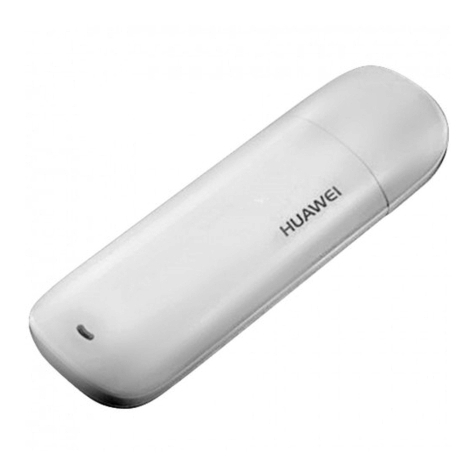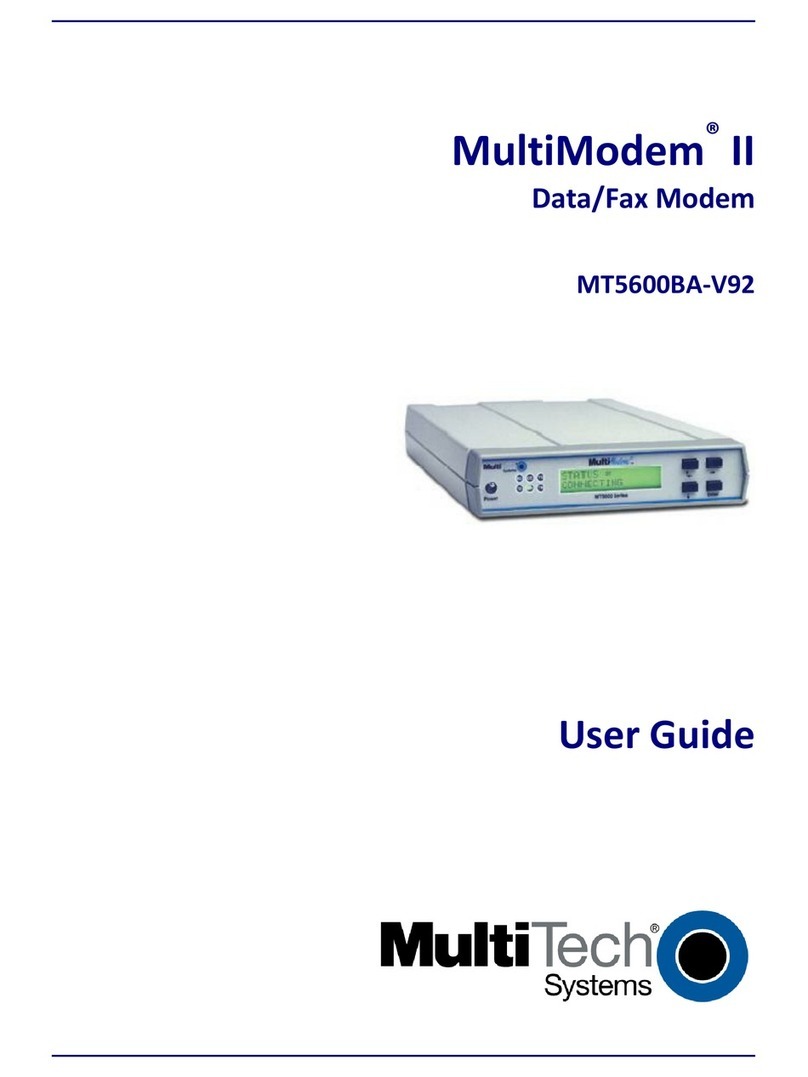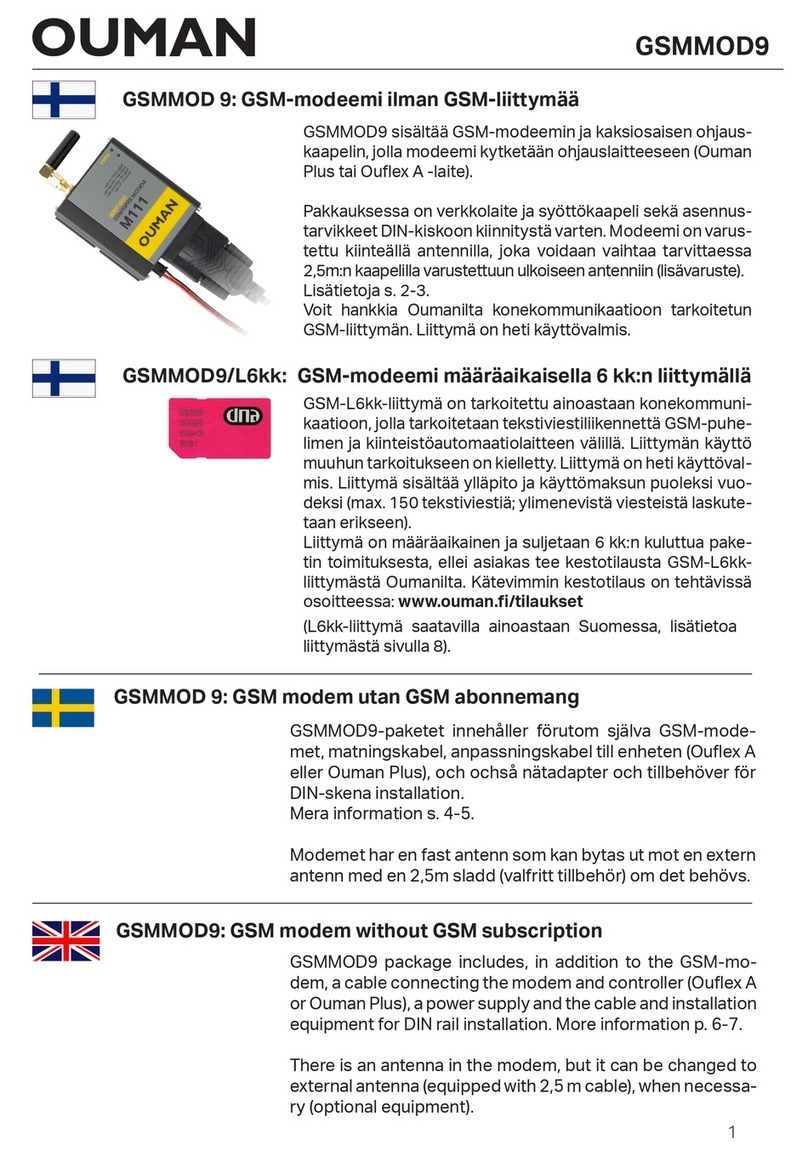Dataplex DPX-213 User manual

DPX-213
LOW POWER DATA MODEM
USER MANUAL
2400/1200/300bps MNP-5 Data
Leased Line & Dial Network Modem

II Document No 113-213-
01 Rev 1.0
WARNING
When operating the DPX213 from a DC supply ensure that any devices that are
connected to the DPX213 have a common NEGATIVE ground or are powered
from an isolated source. It is recommended that the supply be connected via a
disconnection device or an over-current protection device.
SAFETY
The 48V free standing unit is fitted with a 2m power supply cable with bare wire
ends. This power supply cable must be connected to the power source via a
disconnection device or an over-current protection device. A circuit breaker rated
1A, 100 VDC will satisfy both requirements. Observe correct polarity:
•
Red wire to positive;
•
Black wire to negative.
COPYRIGHT
This manual is copyrighted © 1994 by Dataplex Pty. Ltd. with all rights reserved.
This manual cannot be reproduced in any form without the prior written consent
of Dataplex Pty. Ltd. No patent liability is assumed with respect to the use of the
information contained in this manual.
TRADEMARKS
DPX-213 is a trademark of Dataplex Pty. Ltd.
DATAPLEX is a trademark of Dataplex Pty. Ltd.

Document No 113-213-01 Rev 1.0 2008 III
CONTENTS
1.0 INTRODUCTION 1-1
1.1 Features of the DPX-213 1-1
1.2 Requirements 1-1
1.3 About the Manual 1-2
1.4 The DPX-213 Modem 1-3
2.0 INSTALLATION 2-1
2.1 Setting the Internal Jumpers 2-1
2.2 Connecting the DPX-213 to the Telephone Line 2-2
2.3 Connecting a Terminal or Computer to the DPX-213 2-3
2.4 Front Panel Indicators 2-3
2.5 Testing Your Connections 2-4
2.6 Setting Your PC for Speed and Character Format 2-4
2.7 Making a Connection 2-5
2.8 Closing a Connection 2-6
2.9 Call Establishment Sequence 2-6
2.10 Trouble Shooting 2-7
3.0 BEFORE YOU START 3-1
3.1 Command Structure 3-1
3.2 Communications Software 3-1
3.3 Manual and Automatic Calling 3-1
3.4 Dial-up Line and Leased Line Support 3-2
3.5 Speed Matching 3-2
3.6 Flow Control 3-2
3.7 Escape Sequence 3-3
3.8 Advanced Features 3-3
4.0 COMMAND SET 4-1
4.1 Command Line and Command Entry 4-1
4.2 Attention Code Syntax 4-2
4.3 DPX-213 Operating States 4-3
4.4 AT Command Set 4-6

IV Document No 113-213-
01 Rev 1.0 2008
CONTENTS
5.0 APPLICATIONS 5-1
5.1 Resetting the Modem 5-1
5.2 Operating Modes 5-1
5.3 Asynchronous Modes 5-2
5.4 Synchronous Modes 5-3
5.5 Leased Line Operation 5-4
5.6 Extended Character Formats 5-5
5.7 PABX Operating Problems 5-5
5.8 Low Power/Standby Mode 5-6
5.9 Alarm Mode 5-6
5.10 Password Mode 5-6
5.11 Remote Configuration 5-7
6.0 DATA TRANSFER 6-1
6.1 Error Control 6-1
6.2 Flow Control 6-2
6.3 Flow Control Buffers 6-2
6.4 Microcom Networking Protocol 6-4
6.5 Error Free or Not At All 6-5
6.6 Constant Speed Interface 6-5
6.7 File Transfer Restrictions 6-5
6.8 Software Compatibility 6-6
7.0 TESTING AND DIAGNOSTICS 7-1
7.1 Operator Initiated Tests 7-1
7.2 Local Analog Loopback (ALB) 7-2
7.3 Remote Loopback Response 7-2
7.4 Remote Digital Loopback (RDLB) 7-3
8.0 S-REGISTERS 8-1
9.0 TECHNICAL SPECIFICATIONS 9-1
Models Available
10.0 WARRANTY AND REPAIRS 10-1
Warranty Information
Installation and Service Record

Document No 113-213-01 Rev 1.0 2008 V
CONTENTS
APPENDICES
Appendix A Problem Report Sheet
Appendix B S Register Summary
Appendix C ASCII Conversion Table
Appendix D Interface Connections
Appendix E AT Command Set Summary
FIGURES
Figure 2.1 Rear Panel Layout 2-1
Figure 2.2 DPX-213 Jumper Locations 2-2
Figure 2.3 Front Panel Layout 2-3
Figure 5.1 Telecom 604 Plug 5-5
Figure 6.1 Flow Control Buffers 6-2
Figure 7.1 Local Analog Loopback 7-2
Figure 7.2 Remote Digital Loopback 7-3
Figure D.1 RJ-11 Connector Wiring D-1
TABLES
Table 2.1 Front Panel Indicator Names and Functions 2-3
Table 2.2 Valid Character Formats 2-4
Table 4.1 CCITT and Bell Selection 4-7
Table 4.2 Response Codes 4-14
Table 5.1 Mode 0 Asynchronous 5-2
Table 5.2 Mode 1 Asynchronous 5-2
Table 5.3 Mode 2 Synchronous 5-3
Table 8.1 Table for Converting 8 Bit Binary to Decimal 8-1
Table D.1 V.24 Interface Connectors D-2

VI Document No 113-213-
01 Rev 1.0
T
HIS PAGE INTENTIONALLY LEFT BLANK
.

Section 1 INTRODUCTION
Copyright (C) Dataplex Pty Ltd 1-1
1.0 INTRODUCTION
Welcome to the Dataplex DPX-213. Whether you are familiar with dial network modems
or not, you will find the DPX-213 simple to operate. The modem offers advanced features
only found in quality high-end products and opens the door to a new world of data
communications. Congratulations on your purchase of the DPX-213.
1.1 Features of the DPX-213
This low power dial network and leased line data modem is designed for advanced
business and professional applications. A wide range of useful features allow many
different types of networks to be configured with the one compact unit. MNP 4 error
correction and MNP 5 data compression permit error free transmission of data at up to four
times the throughput of basic 2400 bps modems.
The DPX-213 supports five international speed standards for both synchronous and
asynchronous communications.
1.2 Requirements
To operate the DPX-213, it is assumed that the user is reasonably familiar with data
communications concepts and personal computers. If you are unfamiliar with data
communications or personal computers, please refer to the relevant texts or user manuals.
Before you can operate the modem, ensure you have the following equipment:
1. An asynchronous terminal. This can be a personal computer with an RS-232
serial port or a dumb asynchronous terminal. Once configured, synchronous
devices may be used.
2. Data communications software.
3. A DTE (Data Terminating Equipment) cable.

INTRODUCTION Section 1
1-2 Copyright (C) Dataplex Pty Ltd
1.3 About the Manual
The manual is organised to explain increasingly more advanced operations. Novice users
should read all sections, in particular, Section 3 on modem basics and Section 7 on
Applications. The manual is divided into 12 sections as follows:
Section 1 Introduction describes the DPX-213 features and explains how to use this
manual.
Section 2 Installation explains the purpose of each indicator, switch and connector
plus how to connect your modem to the computer and telephone line.
Section 3 Before You Start covers the command method, dialling, answering,
matching dissimilar speeds, leased line and dial network operation.
Section 4 Command Set is probably the most important Section. It explains in detail
the function of each AT command for both fax and normal modem
operation.
Section 5 Applications offers some quick start information on a range of common
uses including password security, synchronous support, leased line
operation, extended character set support and remote configuration.
Section 6 Data Transfer describes advanced features such as error correction, data
compression, flow control and speed matching. This Section also gives some
warnings on set-up conflicts to be avoided.
Section 7 Testing and Diagnostics covers the loopbacks and test patterns available to
help isolate any problem in your cable, modem or phone line.
Section 8 S-Registers covers the software registers used to store the DPX-213
configuration options. Instructions are given to enable reading and altering
the S-Register values.
Section 9 Technical Specifications gives the performance specifications of the DPX-
213 and lists the other models available.
Section 10 Warranty and Repair allows you to record the installation configuration.
Also included is warranty information and a field service request form.
Appendices The appendices contain a problem report sheet, interface signal
leads/connections information, an ASCII code table (in decimal, binary and
hex), an S-registers summary table and the AT Command Set Summary.

Section 1 INTRODUCTION
Copyright (C) Dataplex Pty Ltd 1-3
1.4 The DPX-213 Modem
The DPX-213 is designed and built in Australia and offers:
•
Low Power: Standby current < 100uA.
Operating current < 100mA
•
Wake up on DTE RxD, Ring or Raise of
DTR.
•
Led operation link selectable.
•
DTR wake-up link selectable.
•
Alarm/Dialback function.
•
Password security/dialback.
•
Remote configuration.
•
Async/Sync link selectable.
•
Power from DB25, IDC or Power
Connector.
•
Small size.
•
MNP error correction & data compression.
•
Constant speed interface from 300 to 9,600
bps.
•
Automatic terminal speed detection from
300 to 9,600 bps.
•
Data operation at 300, 1200, and 2400 bps.
•
Auto-ranging on originate and answer at
300, 1200 and 2400 bps.
•
CCITT standards V.21, V.22, and V.22bis.
•
Bell 103 and Bell 212 support.
•
A rugged plastic case.
•
Front panel indicators.
•
Stored number dialling for up to ten
numbers.
•
DTR raise and AT command dialling.
•
Help screens for configuration, S-registers
and AT prompts.
•
Manufactured to ISO-9002/AS-3902 quality
standards.
•
Austel approved.
•
RFI compliant to AS-3458 and CISPR-22
class A.

INTRODUCTION Section 1
1-4 Copyright (C) Dataplex Pty Ltd
T
HIS PAGE INTENTIONALLY LEFT BLANK
.

Section 2 INSTALLATION
Copyright (C) Dataplex Pty Ltd 2-1
2.0 INSTALLATION
Read this Section in order to correctly install your modem. It includes information on
connector pinouts, front and rear panel details and a simple test of your setup.
Before operation is possible, the modem must be setup, either to the factory defaults or
with special S-register values to suit your own configuration.
Most communications software packages issue a default command string to set up the
modem. Before altering this default setup, check the software operations manual and
Section 4, Command Set.
Figure 2.1 Rear Panel Layout
The rear panel of the DPX-213 has a single RJ-11 connector for line, together with a 25
Pin V.24/28 DCE connector. The supplied line cord connects from the RJ-11 of the DPX-
213 to the telephone wall socket. A description of the RJ-11 connectors is given in
Appendix D.
2.1 Setting the Internal Jumpers
The DPX-213 contains a number of internal jumpers which have to be set before
operation. The figure over page shows the location of the various jumpers.

INSTALLATION Section 2
2-2 Copyright (C) Dataplex Pty Ltd
U1
RESET
Figure 2.2 DPX-213 Jumper Locations
J4: Removing this jumper reduces current consumption by disabling the front panel
LEDs.
J5: Removing this jumper stops the V.24 DTR input which controls the standby mode
of the DPX-213. Without this jumper set, the unit will not wake up on raise of DTR
and will not be held active by the DTR when the unit is placed in standby mode.
J8: This jumper enables the sync clocks on the V24 interface. When Pins 1 and 2
are shorted no sync clocks will be present at the interface. When Pins 2 and 3 are
selected, both Rx and Tx sync clocks will be placed on Pins 17 and 15 of the DB25
connector.
2.2 Connecting the DPX-213 to the Telephone Line
Remove your telephone from its wall socket (you may need a flat bladed screwdriver for
this) and plug one end of the supplied cable into the socket labelled "J2 LINE" on the rear
of the DPX-213 and plug the other end into the wall socket. The terminal prompts will
give call progress indication.
NOTE: 1. Dataplex does NOT recommend the use of double adaptors to connect your
telephone in parallel with the DPX-213. Should the handset be lifted when the
modem is online, noise and errors will be injected into the data stream.
2. If the handset draws power from the telephone line (for example, to keep stored
numbers intact or to run a clock display) the battery charging current can be a
source of noise and errors in the data during long modem sessions. A long data
call may cause the telephone memory battery to discharge and lose the stored
numbers.

Section 2 INSTALLATION
Copyright (C) Dataplex Pty Ltd 2-3
2.3 Connecting a Terminal or Computer to the DPX-213
The DPX-213 uses the industry standard 25 Pin "D" connector as its data interface, with
the signals defined in the CCITT V.24, V.28 and EIA RS-232C for modems. The DPX-
213 operates as Data Circuit-terminating Equipment (DCE).
If you wish to connect the DPX-213 to a terminal or computer with a serial port configured
as Data Terminal Equipment (DTE), then a "straight through" cable connecting
corresponding pins of the serial ports should work. If the computer serial port is configured
as a DCE, then you must use a "cross over" or "null modem" cable. Most personal
computers and terminals have their serial interface configured for DTE operation. The
connections needed for dumb terminals, PC's and asynchronous operation are described in
Appendix D.
NOTE: When connecting the RS-232 cable to the PC, DO NOT connect the cable to the
DB25 female connector on the rear of the PC. This is the parallel port and
connection may cause damage to your PC. At the PC end, the cable should be
connected to a male connector (serial port) for correct operation.
The terminal cable to the modem should be less than 15 meters in length and restrained
with screw locks at both ends to avoid placing too much strain on the cable. Round cable is
recommended. Ribbon cables MUST be kept as short as possible to minimise clock and
data interference in the ribbon.
2.4 Front Panel Indicators
The front panel of the DPX-213 contains 4 LED's (Light Emitting Diodes), which are used
to indicate modem and line status.
Figure 2.3 Front Panel Layout

INSTALLATION Section 2
2-4 Copyright (C) Dataplex Pty Ltd
Table 2.1 Front Panel Indicator Names and Functions.
Name Function Colour Status
TD Transmit Data Yellow Off for mark, On for space, flickering for data
RD Receive Data Yellow Off for mark, On for space, flickering for data
CD Carrier Detect Green On when CD active, Off when CD inactive.
(See AT&C command)
OH Off Hook Red On when modem is on line (Off hook). Off
when modem is off line (On-hook).
When the modem is in Loop modes this LED
flashes.
2.5 Testing Your Connections
With your terminal or computer connected and operating, the DTR LED should light. You
can now perform a quick test to determine if you have setup the DPX-213 correctly.
After connecting your terminal or PC to the modem, power the system up and start your
communications or terminal emulation package. To check that keyboard characters are
reaching the DPX-213, the TD LED must flash with every keystroke.
Press the Kkey. Each time you press the key, the TD LED should flash briefly. If no
data is reaching the DPX-213, check that:
1. The correct COM port is being used on your PC;
2. The terminal is in the ON-LINE state and not the LOCAL Mode state, or,
3. The correct cable is being used and the cable pinouts are correct.
2.6 Setting Your PC for Speed and Character Format
The DPX-213 uses the attention request ('AT' prefix) to automatically detect terminal
speeds at all standard baud rates up to 9,600 baud.
For initial configuration, the terminal used must be a ten bit ASCII device operating at one
of the standard speeds, for example, 300, 1200, 2400, 4800, 9600 or 19,200 bps. The AT
command processor and Constant Speed Interface accept character formats of 10 bits in
total.
For example:

Section 2 INSTALLATION
Copyright (C) Dataplex Pty Ltd 2-5
Table 2.2 Valid Character Formats
Start Bit Data Bits Parity Stop Bits Total Bits
1 7 Mark 1 10
1 7 Even 1 10
1 7 Odd 1 10
1 7 Space 1 10
1 8 None 1 10
2.7 Making a Connection
Make sure the cable and terminal software are correct, then type atK. This allows
the modem to sense the terminal speed and calculate the parity being used. After this has
been successfully decoded, the DPX-213 will reply with:
"OK"
NOTE: If the modem fails to issue the "OK" response, and you are certain the cable,
terminal speed and parity are all correct, refer to the Section on Testing and
Diagnostics.
The DPX-213 comes with a default configuration suitable for many applications. As a
"soft" configured product, it is possible to make errors by loading a conflicting
configuration, causing unpredictable operation. If you suspect this has happened, turn the
power off, wait about ten seconds, and then turn the power back on. Force the modem back
to the factory default setup by typing at&fK.
Otherwise, type ath1K to force the modem to go Off Hook (equivalent to lifting
the handset). Typing the command line athK or ath0K will terminate
the call.
Dial a number by typing the command line: atd 1234567K.
(Fictitious Number Only)
The above command tells the modem to dial (ATD) the number 1234567. Where non-
standard dial tones are used, such as with some PABX's, the modem may not be able to
detect dial tone. In this case select the appropriate pulse or tone dialling method with the
ATDP or ATDT commands respectively and ensure the modem "blind dials" by using the
ATX0 or the ATX2 command.
When dialling a number, you should see various prompts on your terminal.

INSTALLATION Section 2
2-6 Copyright (C) Dataplex Pty Ltd
2.8 Closing a Connection
There are several ways to abort a call. If the call has been answered by a modem and both
are on-line, typing any key will now send that character to the attached modem. Aborting
the call in this case must be done from the on-line interactive state which is entered by
typing the escape sequence of 'pause' +++ 'pause' followed by athK.
The abort timer (S-Register 7) will also abort the call if the originating modem has not
established a call before S7 times out. This is normally 45 seconds but can be between 1
and 255 seconds.
Basically, a call can be terminated in several ways :
•
Hitting any key on the terminal;
•
Detection of busy tone by the DPX-213;
•
Time-out of the modem (S-Register 7);
•
Loss of carrier;
•
Typing the escape sequence ('pause' +++ 'pause') then ath0K.
Additionally, a call will be terminated when either Busy tone (engaged) is detected or loss
of power is applied to the modem by switching off or removing the power cord.
NOTE: If data is present, then one of the Dumb modes should be used (AT*D2).
2.9 Call Establishment Sequence
The modem placing the call is termed the originating modem and the modem at the other
end is termed the answering modem. When instructed to place a call, the originating
modem will go off-hook and the OH LED will illuminate. Typically, the originating
modem listens briefly for dial tone before dialling, places the call, and then listens for
answer tone from the answering modem. If no tone is received within a preset time (stored
in S-Register 7), the call is aborted.
The originating modem is usually silent during this initial call set-up phase, but a calling
tone can be enabled (via the AT*G command) which transmits an interrupted tone so the
called party can distinguish a data call from a voice call and activate the modem if
required.
At the answering end, the modem detects the incoming ring, counts up to the preset
number of rings (stored in S-Register 0) and then goes off-hook. It transmits an answer
tone to the calling modem. Once this tone is detected by the calling modem the training
sequences begins. Therefore, it usually takes a few seconds before data transfer actually
begins.

Section 2 INSTALLATION
Copyright (C) Dataplex Pty Ltd 2-7
The called modem will turn on the ring indicator with each incoming ring (Pin 22). It will
usually output the word "RING" to the terminal with each incoming ring unless this feature
has been disabled with the ATQ or ATV commands.
The DPX-213 can be configured so it will:
•
Answer at a particular ring count (typically, the answering modem will be set
to answer on the first or second ring;
•
Never answer;
•
Answer if the data terminal ready lead (Pin 20) is asserted.
2.10 Trouble Shooting
If you are sure you have the correct cables, terminal speed and ASCII character format, but
are unable to get the OK response from typing AT, the DPX-213 may have an invalid set-
up string stored in the NVRAM.
A Master Reset should eliminate this problem. A Master Reset will erase all stored
numbers, passwords and configuration information. To initiate the Master Reset, turn the
DPX-213 power off, remove the lid and short the reset pads on the PCB while turning the
power back on. Wait a few seconds before removing the short
Now type atK as before. If you still experience problems, consult Section 7 on
Testing and Diagnostics or call your modem supplier for assistance. Details of the
Warranty and Service contacts are given in Section 10.

INSTALLATION Section 2
2-8 Copyright (C) Dataplex Pty Ltd
T
HIS PAGE INTENTIONALLY LEFT BLANK
.

Section 3 BEFORE YOU START
Copyright (C) Dataplex Pty Ltd 3-1
3.0 BEFORE YOU START
The DPX-213 is a combined soft-strapped and link selectable modem. There are number of
internal links which can be used to select Async/Sync operation, DTR wakeup and LED
operation. All other parameters are set by software commands from an attached
asynchronous terminal and then stored in Non Volatile Random Access Memory
(NVRAM). These setups or configurations are stored in 'S-registers'.
3.1 Command Structure
In general, commands entered into the modem are prefixed with 'AT' and end with a
carriage return ( K
).
The modem automatically determines the terminal speed and
parity from the AT characters, loads the command into a buffer as you type it, and executes
the command when you hit the carriage return.
The factory defaults assume you are going to use the modem for asynchronous operation
on the dial network at the fastest speed the line or modem can accommodate. The character
format is assumed to be 10 bit ASCII, consisting of 1 start bit, 8 data bits and 1 or more
stop bits. For 8 to 11 bit configurations, read Section 5 on Applications and Section 8 on S-
Registers.
3.2 Communications Software
The software used to configure the DPX-213 can range from simple dumb terminal
emulators to advanced communications systems. The DPX-213 is compatible with
virtually all communications software packages. If using a smart communications package,
ensure it supports the AT command set. Most packages also send an initialisation string.
This should be checked for correctness before using the modem.
3.3 Manual and Automatic Calling
Calls can be initiated by raising DTR from the terminal and typing an AT command string.
Calls can be answered by the same methods.

BEFORE YOU START Section 3
3-2 Copyright (C) Dataplex Pty Ltd
3.4 Dial-up Line and Leased Line Support
The DPX-213 cannot share the same line as your normal telephone. It can only be used in
isolation.
NOTE: Telephones with Mode 3 connectors should not be used with this equipment.
Contact Telecom if you are trying to use the modem on a small business key
system such as a Commander, as these hand sets often signal to the PABX
electronics with non standard tones and voltages. Damage to either the PABX or
the modem could result from incorrect connection. A direct line from the local
exchange may be needed in these situations.
Leased lines are special services providing a dedicated link between two sites. No
switching is involved and hand sets are rarely provided. The DPX-213 can be configured
to operate on two wire leased lines in synchronous or asynchronous modes. Special care
has been taken with the design to ensure reliable operation in leased line mode, particularly
with line changes caused by circuit re-routing. Section 5, Applications, details the
recommended set-up strings for this use. Leased line also requires modifications to the line
connector as shown in Appendix D.
3.5 Speed Matching
There are several forms of speed matching used in the DPX-213. The autobaud feature
automatically senses the terminal speed from the typed AT commands and sets the modem
interface speed to match the terminal. The autoranging feature automatically senses the
line speed of the remote modem and adjusts to it in both originate and answer modes.
Additionally, there is a Constant Speed Interface (CSI) on the DPX-213 modem which
allows your terminal to remain at the same speed, say 9,600 bps, for all 300, 1200 or 2400
bps full duplex calls. This simplifies operation with mini-computer systems provided you
support flow control and avoids data loss if there is a speed mismatch in the system.
3.6 Flow Control
Flow control is needed whenever one device in the system runs faster or slower than
another, or there are delays in transmission while errors are corrected. Flow control can be
In-band using Xon and Xoff characters or Out-of-band using Request To Send (RTS) and
Clear To Send (CTS). These are also referred to as software handshaking or hardware
handshaking. It is legitimate to have different flow control techniques at each end of the
link. The Xon and Xoff characters are user programmable in the DPX-213 and are stored
in S-Registers 32 and 33 respectively.
Table of contents

